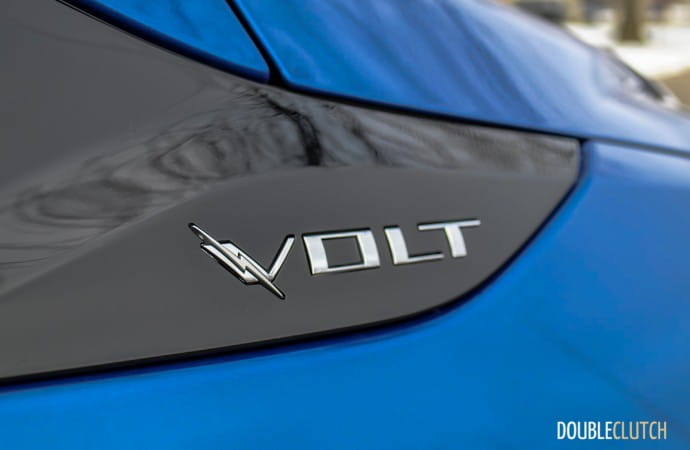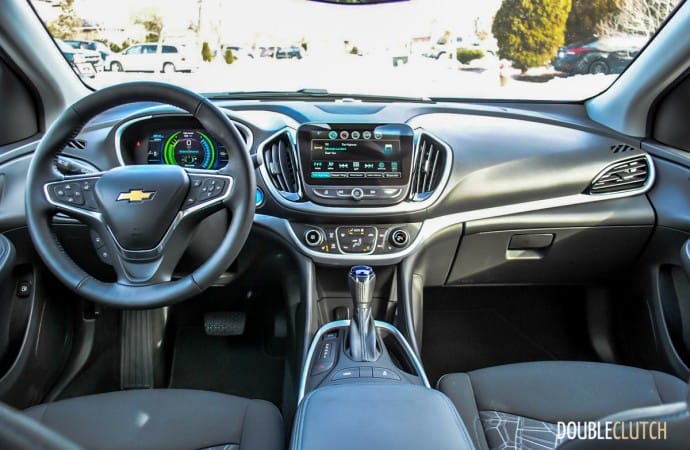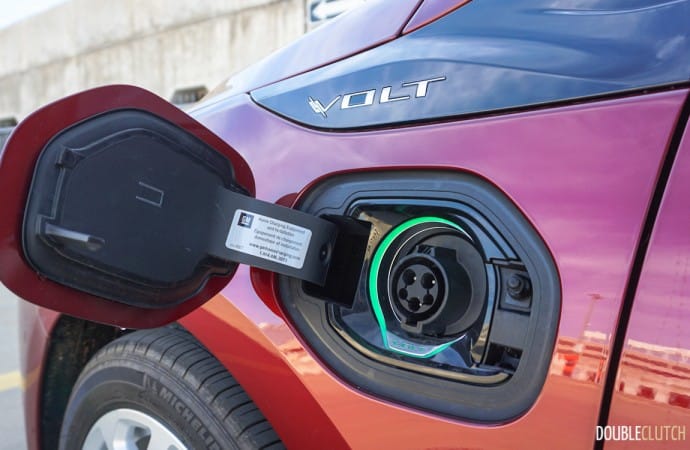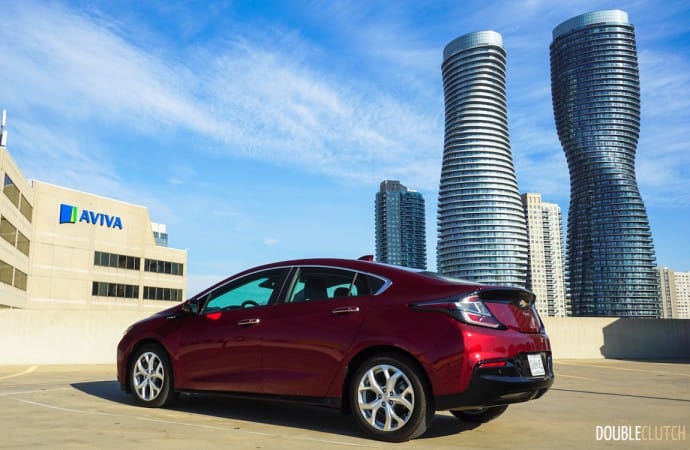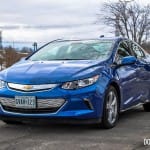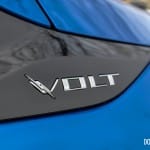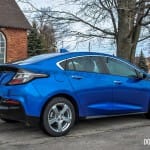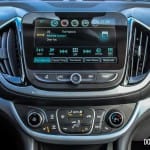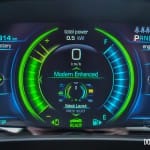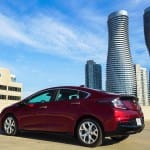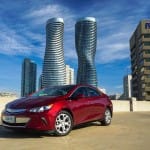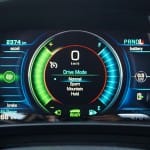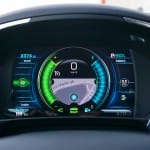I’ve slowly been swayed after spending my fair share of time behind the wheel of some exceptional examples. With cars like the Honda Accord PHEV and the Tesla Model S (see our review), I’ve seen firsthand just how far the technology has come. GM got serious about the green game back in 2011 when the Volt was released, and as it enters its second iteration, the Volt has earned a name for itself as a force to be reckoned with. Eager to see how a dedicated eco car could fit into my daily routine I borrowed a 2016 Chevrolet Volt LT, the first of the second-generation model.
Unlike a lot of cars, the Volt only really has two option packages. The base LT comes extremely well equipped for a base model including features such as LED headlamps, heated front seats, heated steering wheel, automatic climate control, proximity key, ambient LED interior lighting and a crystal clear 8” touch screen with the latest version of Chevrolet‘s MyLink infotainment. Stepping up to the Premier adds leather seating, heated rear seats and bigger 18” rims. My LT tester was priced to compete at $38,945, and you’ll need to add $4,100 to get into a Premier. The only option on my tester is the $455 Kinetic Blue Metallic paint.
The Kinetic Blue does suit the car’s modern and muscular styling quite well and I actually consider the design to be one of the Volt’s strong points. It doesn’t scream “look at me! I am saving the environment!” Instead, its general shape conforms to that of the latest compact sedans, while details like the closed-off chrome grills and unique tail light treatment hint that there’s something slightly different about this car.
I was also very pleased to discover that the Volt is not really a sedan as its profile might have you believe. Its nearly horizontal rear window opens as a hatchback – similar to the 80s and 90s notchback coupes that I hold so dear to my heart. This alone adds some appeal to this car for me as it makes it much more useful than a typical compact. Folding the rear seats flat reveals an expansive cargo area that’s ideal for all sorts of awkward and bulky items. I found the space much more usable than in a Toyota Prius, which uses a very similar design yet feels considerably more restricted.
The interior of the Volt is just as practical as the exterior, with comfortable heated cloth seats, plenty of head and legroom for rear passengers and well thought-out storage compartments up front. Interior build quality and materials are a significant improvement over the previous generation, and even over key competitors like the Prius. The refreshed MyLink infotainment system, essentially the same as any other Chevrolet product, offers a crystal clear LCD screen, lighting quick response time and simple menus. The system’s new refinements put it right up there with the best in the industry. The LCD instrument cluster can also be configured a number of different ways, all representing different views and information to help you maximize efficiency and get the most out of your Volt.
The new Volt will run strictly on battery power until the battery’s reserve starts to run low. At that point, the 1.5L 4-cylinder gasoline engine will fire up and function as a generator to extend the car’s range. Periodically, the power management system will connect the engine directly to the drive gears to propel the car, but only when it’s most efficient to do so. The combination of the gas engine and the 18.4kWh battery make a peak power output of 149 horsepower, and with the instant torque of the electric power the Volt actually feels rather peppy and effortlessly keeps up with the flow of traffic, even passing slower vehicles on the highway with ease.
My time with the Volt fell on the coldest week of the year here in Toronto. With a rush hour commute of 55km (one-way), the Volt definitely had its work cut out for it. I received the car with a full charge and despite the -15C temperatures I was able to make it about 90% of the way to work the first morning without using any gasoline at all. Unfortunately I was unable to charge at my office, so my entire drive back home had to be without any reserve battery power. In those unideal scenarios, the Volt operates similar to a standard hybrid, using regenerative braking and using the engine to power its electric generator to make the most use of the battery as possible.
Arriving home after work I’d plug the Volt in using the supplied 110V charger; a full charge this way can take up to 18 hours depending on factors such as temperature. For that reason, by the time I was leaving for work the next morning I’d only have about 75% of a charge, which got me about 75% of the way to work before reverting to the gasoline generator. After 5 days of this my average fuel economy sat at 4.5L/100kms – still quite impressive given the distance covered and extreme cold conditions. If I had access to a 220V charger at home (a must for anyone buying one of these), I likely could have done much better. Even more so, if I had the ability to charge at my workplace, as many offices now do, I would have been able to commute without using any fuel at all.
In exchange for that efficiency I really only made one noteworthy trade-off and that is the interior heat. Since generating heat is very inefficient the Volt is set up to minimize use of the heater. Left in “Auto” mode the system will promptly bring the car to a hospitable temperature and clear the fogging windows, but if you’re like me and prefer a toasty hot car you’ll need to push the “max” button which will heat up the car rather quickly while sacrificing driving range. Using the heated steering wheel and seats is a more efficient use of power and is a good way to offset the lack of heat when you’re trying to be as green as possible.
Beyond the heat, the Volt drives and feels just like a normal car. In fact it drives like a very good normal car. The steering is responsive and offers enough road feel for me, the car handles well, rides comfortably and the cabin is tight and quiet. I didn’t think I’d ever say this, but this practical eco car is actually fun, engaging and comfortable to drive – there are very few things not to love here.
I came away from my week with the 2016 Chevrolet Volt LT thoroughly impressed. The engineers at GM have built a car that represents the most livable, affordable and practical eco car I’ve driven to date. Under different circumstances this is a car that can easily be driven daily without ever really using any significant amount of fuel, and with very little sacrifice or compromise on the driver’s part. I consider the Volt to be sort of a “Cruze Electric”, and if the new Cruze feels and drives as good as this Volt does, GM will have a strong contender in the traditional compact market on their hands. Either way, Chevrolet’s Prius-fighter is now better than ever and finally proves that economical motoring doesn’t have to be painful.


